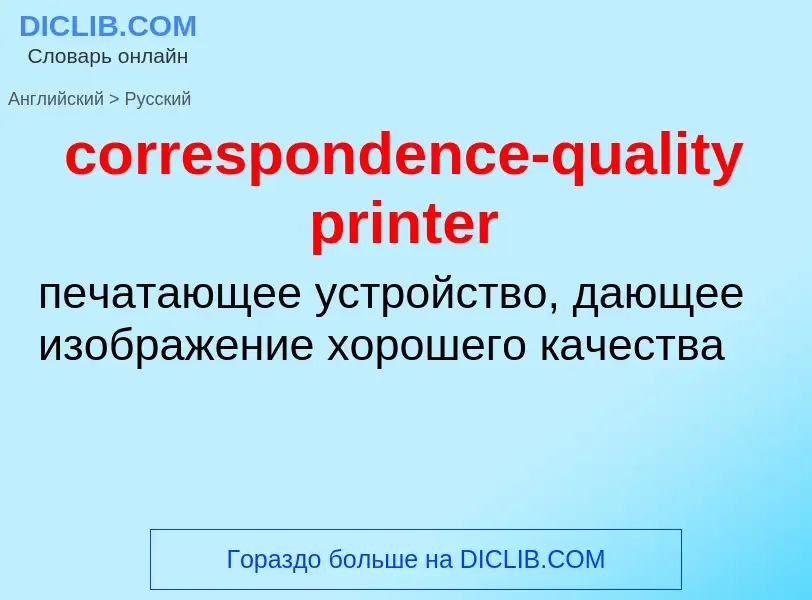Перевод и анализ слов искусственным интеллектом ChatGPT
На этой странице Вы можете получить подробный анализ слова или словосочетания, произведенный с помощью лучшей на сегодняшний день технологии искусственного интеллекта:
- как употребляется слово
- частота употребления
- используется оно чаще в устной или письменной речи
- варианты перевода слова
- примеры употребления (несколько фраз с переводом)
- этимология
correspondence-quality printer - перевод на русский
общая лексика
высококачественная печать, режим высококачественной печати, режим LQ, машинописное качество
качество матричной или ромашковой печати, соответствующее требованиям деловой переписки и приближающееся к качеству печати пишущей машинки. Термин несколько устарел, так как лазерные и струйные принтеры обеспечивают даже более высокое качество печати
синоним
Смотрите также
общая лексика
устройство контактной печати, принтер [печатающее устройство] ударного действия
любой принтер, в котором печатающая головка перемещается и контактирует через красящую ленту с бумагой, например матричный принтер
Определение
Википедия
A letter-quality printer was a form of computer impact printer that was able to print with the quality typically expected from a business typewriter such as an IBM Selectric.
A letter-quality printer operates in much the same fashion as a typewriter. A metal or plastic printwheel embossed with letters, numbers, or symbols strikes an inked ribbon, depositing the ink (or carbon, if an expensive single-strike ribbon was installed) on the page and thus printing a character.
Over time, several different technologies were developed including automating ordinary typebar typewriter mechanisms (such as the Friden Flexowriter), daisy wheel printers (dating from a 1939 patent, but brought to life in the 1970s by Diablo engineer David S. Lee) where the type is moulded around the edge of a wheel, and "golf ball" (the popular informal name for "typeball", as used in the IBM Selectric typewriter) printers where the type is distributed over the face of a globe-shaped printhead (including automating IBM Selectric mechanisms such as the IBM 2741 terminal). The daisy wheel and Selectric-based printers offered the advantage that the typeface was readily changeable by the user to accommodate varying needs.
These printers were referred to as "letter-quality printers" during their heyday, and could produce text which was as clear and crisp as a typewriter (though they were nowhere near the quality of printing presses). Most were available either as complete computer terminals with keyboards (or with a keyboard add-on option) that could double as a typewriter in stand-alone ("off-line") mode, or as print-only devices. Because of its low cost at the time, the daisy wheel printer became the most successful, the method used by Diablo, Qume, Brother and Apple.
Letter-quality impact printers, however, were slow, noisy, incapable of printing graphics or images (unless the programmable microspacing and over-use of the dot were employed), sometimes limited to monochrome, and limited to a fixed set (usually one) of typefaces without operator intervention, though certain font effects like underlining and boldface could be achieved by overstriking. Soon, dot-matrix printers (such as the Oki Microline 84) would offer "Near Letter Quality" (NLQ) modes which were much faster than daisy-wheel printers, could produce graphics well, but were still very noticeably lower than "letter quality". Nowadays, printers using non-impact printing (for example laser printers, inkjet printers, and other similar means) have replaced traditional letter-quality printers in most applications. The quality of inkjet printers can approach the old letter-quality impact printers (but can be limited by factors such as paper type).





![[[Epson]] MX-80, a popular model of dot-matrix printer in use for many years [[Epson]] MX-80, a popular model of dot-matrix printer in use for many years](https://commons.wikimedia.org/wiki/Special:FilePath/Epson MX-80.jpg?width=200)
![adj=on}} [[tractor-feed paper]]. They were also called "132-column printers". adj=on}} [[tractor-feed paper]]. They were also called "132-column printers".](https://commons.wikimedia.org/wiki/Special:FilePath/Epson Wide Carriage 9-pin printer - with legal paper 8.5x14.jpg?width=200)








